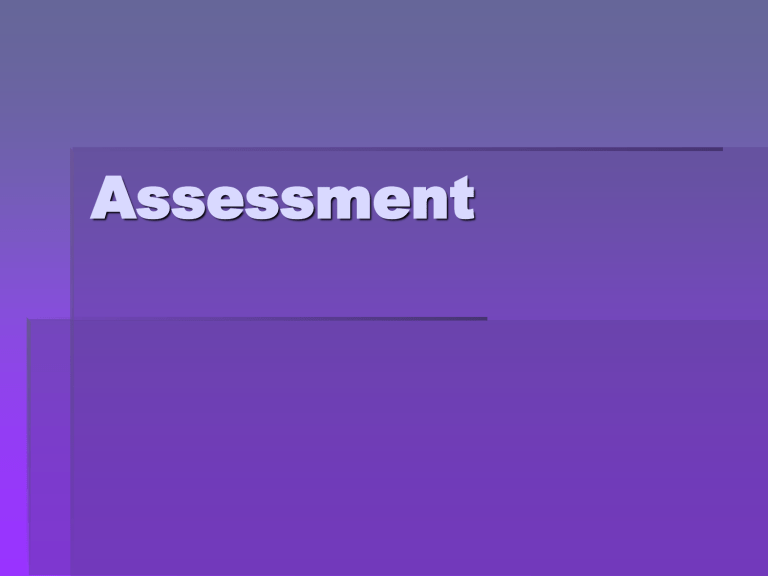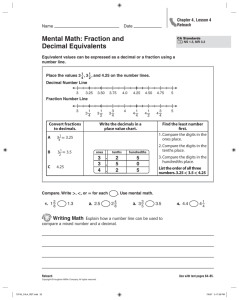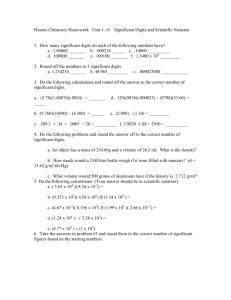Error Analysis - People Server at UNCW

Assessment
National Research Council
(2001)
“students need to be efficient and accurate in performing basic computation with whole numbers” (p. 121)
students must learn to “use an algorithm for computation with multi-digit numbers because it is an important part of developing mathematical proficiency”
(p.7)
Assess these skills?
Curriculum-Based Measurement
Developed more than 25 years ago (Stan Deno)
Reliable & valid way of assessing student progress in the basic skill areas
CBM-Probes ~ narrow-band tests ~ are simple to administer and score & sensitive to improvement & time efficient
Science-based research (Marston, 1989; Thurber &
Shinn, 2002) ~ having students write answers to grade-level computational problems for 2-4 min. is a reliable and valid outcome measure for typically achieving and those with severe problems (all fact probes are 2 minutes)
Probes
Correct digits
Older students (grades 5 & beyond) – in answer or answer & critical processes but grades 1-4 answer only
Standardized directions
“We’re going to take a 2 (or 4) -minute math test. I want you to write your answers to these math problems. Some are ___ and some are _____. Look at each one carefully before you write the answer.
When I say begin, write your answer to the first problem (point) and work across the page (show).
Then go to the next row. Keep doing this until I say stop. Try to work each problem. If you really don’t know how to do it, put an x through it and go to the next problem.” At the end of 2 minutes say, “Stop.”
Testing ~ not teaching
No skipping (“try to work each problem”)
Scoring Guidelines
Correct digits
Each correct digit is underlined and counted
Incomplete problem ~ count correct digits
Xed out ~ count correct digits
Poor legibility & difficult to determine the number ~ count incorrect
Reversed but obvious ~ (3) count correct
Probes?
AIMSweb ~ www.aimsweb.com
Intervention Central ~ www.interventioncentral.org
GRAPH RESULTS!!!
Computer
By hand
State Measures
http://community.learnnc.org/dpi/math/arc hives/instructional_resources/index.php
Error Analysis
Diagnosing Errors
• Step 1: Analyze errors and make a hypothesis about the cause of the errors
• Step 2: Interview student to determine cause of the error (if not obvious)
• Step 3: Reteach
• Step 4: Test
Error Types
• Fact Error
• Component Skill Error
• Strategy Error
Fact Error
• Basic facts ~ 100 addition and multiplication facts formed by adding or multiplying any 2 single-digit numbers and their subtraction and division counterparts
• Student follows the correct sequence of steps for solving the problem but misses the problem because of a basic fact error
Fact Error Remediation
• Does the student miss a certain fact consistently?
– If so, the remediation must involve practice on that fact
• Does the student miss a fact inconsistently?
– Increase incentives for accurate work (so students do not rush through work and make careless errors)
Component Skill Error
• Previously taught skills that are integrated as steps in a problem-solving strategy
• Lower grade ~ counting or symbol identification error
• Later grades ~ wider range
Component Skill Error
Remediation
• Is the error occurring consistently?
– If no, don’t remedy
– If yes, reteach the particular component skill for AT LEAST 2 consecutive days.
Once the student can perform that skill with mastery, reintroduce examples of the problem type that was originally missed.
Strategy Error
• Student does not know the sequence of steps to solve the problem type
Strategy Error Remediation
• Reteach the strategy ~
– Using a highly structured presentation







